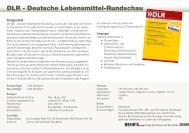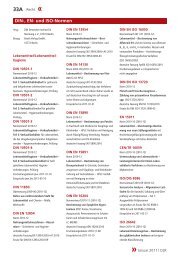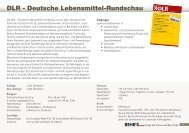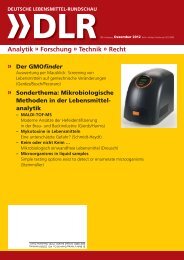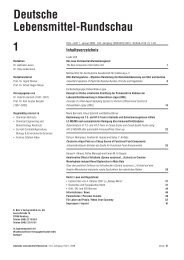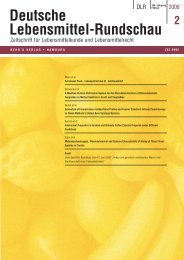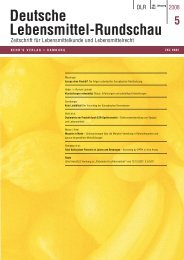Nanotechnologie in Lebensmitteln - DLR Online: Deutsche ...
Nanotechnologie in Lebensmitteln - DLR Online: Deutsche ...
Nanotechnologie in Lebensmitteln - DLR Online: Deutsche ...
Sie wollen auch ein ePaper? Erhöhen Sie die Reichweite Ihrer Titel.
YUMPU macht aus Druck-PDFs automatisch weboptimierte ePaper, die Google liebt.
Development and Characterization of a Piezoelectric Immunosensor for Determ<strong>in</strong>ation of Domoic<br />
Acid <strong>in</strong> Food Samples<br />
Summary<br />
In the present study a label-free piezoelectric crystal immunosensor,<br />
based on an <strong>in</strong>direct competitive assay format, for the detection of<br />
domoic acid (DA) <strong>in</strong> shellfish is described. After physical absorption<br />
of the conjugate on the gold surface of the quartz crystals a competition<br />
step was performed by putt<strong>in</strong>g <strong>in</strong> contact with the crystal a solution<br />
conta<strong>in</strong><strong>in</strong>g the specific polyclonal antibody aga<strong>in</strong>st domoic acid<br />
and the DA as free tox<strong>in</strong>. The build up of mass on the crystal surface,<br />
registered as a frequency decrease by the quartz crystal microbalance,<br />
can be related to the amount of free tox<strong>in</strong> <strong>in</strong> the solution <strong>in</strong><br />
the 0–10 µg/g range. The sensor is capable to measure domoic acid<br />
at the established regulatory level (20 µg/g) after a 1:4 (v/v) dilution<br />
of the sample extract. The repeatability obta<strong>in</strong>ed by us<strong>in</strong>g three different<br />
crystals was lower than 7%. Regeneration assays have shown<br />
the possibility to reuse the modified surface by us<strong>in</strong>g 0.1 M NaOH as<br />
dissociation agent. The sensor could have application as screen<strong>in</strong>g<br />
method for compliance with European food legislation.<br />
Zusammenfassung<br />
Diese Arbeit beschreibt e<strong>in</strong>e Methode zur Bestimmung von Domo<strong>in</strong>säure<br />
(DA) <strong>in</strong> Schalentieren. E<strong>in</strong>gesetzt wurde e<strong>in</strong> piezoelekrischer<br />
Immunsensor, der auf e<strong>in</strong>em <strong>in</strong>direkten kompetitiven Assay basierte.<br />
Zuerst wurde die Goldoberfläche des Kristalls mit e<strong>in</strong>em Prote<strong>in</strong>-DA-<br />
Konjugat beladen und anschließend <strong>in</strong> e<strong>in</strong>e Lösung aus polyklonalem<br />
DA-Antikörper und freier Domo<strong>in</strong>säure gegeben. Die Massenveränderung<br />
an der Kristalloberfläche führte zu e<strong>in</strong>er Resonanzfrequenz-<br />
Verschiebung des Quarzkristalls. Aus dieser Verschiebung konnte<br />
die Menge an freiem Tox<strong>in</strong> <strong>in</strong> der Lösung bestimmt werden (Bereich:<br />
0–10 µg/g). Mit diesem Sensor war es möglich die DA-Konzentration<br />
im Bereich der zulässigen Höchstmenge von 20 µg/g nach e<strong>in</strong>er<br />
1:4-Verdünnung der Probeextrakte zu bestimmen.<br />
Introduction<br />
Domoic acid (DA) is a neuroexcitatory tox<strong>in</strong> that has been<br />
identified <strong>in</strong> mar<strong>in</strong>e samples. This neurotoxic am<strong>in</strong>o acid is<br />
responsible of amnesic shellfish poison<strong>in</strong>g, which <strong>in</strong>cludes<br />
gastro<strong>in</strong>test<strong>in</strong>al and neurological disorders. For human consumption,<br />
a maximum content of 20 mg/kg of DA was established<br />
<strong>in</strong> the Commission Decision 2002/226/EC 1) . Because<br />
of the occurrence of this natural tox<strong>in</strong> is so widespread,<br />
there is an urgent need to develop simple and sensitive methods<br />
that can be used for quality control <strong>in</strong> order to guarantee<br />
the food safety for the consumer.<br />
The techniques most extensively used for that purpose are<br />
based on liquid chromatography with UV and fluorescence<br />
<strong>DLR</strong> | November/Dezember 2008 «<br />
67<br />
Ana Rodríguez #1,2 , Josefa Barrero1 , Andri Papadopoulou1 and<br />
Francois Rossi1 1 European Commission, Jo<strong>in</strong>t Research Centre, Institute for Health<br />
and Consumer Protection, Via E. Fermi 1, I-21020 ISPRA (VA) Italy<br />
2 University of Santiago de Compostela, Santiago de Compostela E-<br />
15782, Spa<strong>in</strong><br />
detection; although these methods present high sensitivity<br />
they are time-consum<strong>in</strong>g and require expensive <strong>in</strong>strumentation<br />
2,3) . In recent years, the rapid detection methods<br />
are ga<strong>in</strong><strong>in</strong>g popularity and acceptance as a simple alternative,<br />
s<strong>in</strong>ce they are a very useful as screen<strong>in</strong>g tools and<br />
excellent complement to confirmatory methods. Several<br />
enzyme-l<strong>in</strong>ked immunosorbent assays (ELISA) for domoic<br />
acid have been reported <strong>in</strong> the literature 2,4–6) however<br />
other methods such as electrochemical immunosensors,<br />
for determ<strong>in</strong><strong>in</strong>g the tox<strong>in</strong>, based on screen-pr<strong>in</strong>ted electrodes<br />
have also been described 3,7) . Another technique<br />
suitable for immunoanalysis of DA is based on the Quartz<br />
Crystal Microbalance (QCM), a sensitive acoustic technique<br />
that allows the measurement of resonance frequency<br />
shifts attributed to changes <strong>in</strong> the total oscillat<strong>in</strong>g<br />
mass of a piezoelectric crystal. In these systems a shift <strong>in</strong><br />
the frequency of the quartz crystal, registered dur<strong>in</strong>g the<br />
antigen-antibody reaction, is converted to a mass change<br />
on the crystal surface determ<strong>in</strong>ed us<strong>in</strong>g the Sauerbrey equation<br />
8) (*).<br />
(*) ∆m = –<br />
c ∆f<br />
n<br />
where, C = 17.7 ng Hz -1 cm -2 for a 5 MHz quartz crystal,<br />
n = 1, 3, 5, 7 is the overtone number.<br />
Piezoelectric transducers, be<strong>in</strong>g high sensitive direct mass<br />
sensors 9) , allow apply<strong>in</strong>g label-free techniques <strong>in</strong> immunoassays<br />
which are known to be advantageous <strong>in</strong> terms of<br />
simplicity of performance and rapidity. These systems have<br />
been successfully applied <strong>in</strong> different areas; analysis of contam<strong>in</strong>ants<br />
10,11) , evaluation of prote<strong>in</strong> immobilization 12) , nucleic<br />
acid sensors 13) , cl<strong>in</strong>ical analysis 14) .<br />
In this study, the development and characterization of a<br />
piezoelectric sensor for determ<strong>in</strong>ation of domoic acid on<br />
the basis of a competitive assay is reported.<br />
# Dr. Ana Rodriquez, phone: +34981598450, Fax: +34981594912,<br />
e-mail: anarbq@usc.es<br />
» Orig<strong>in</strong>alarbeiten




